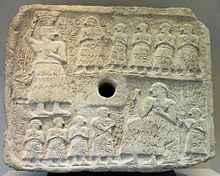Kaunakes
The Kaunakes ( plural , Greek καυνάκης ) originally referred to a fur made of mouse or weasel fur , then the half-skirt made of fur of the Sumerians of the 4th millennium BC, which emerged from an apron . BC, finally the Mesopotamian skirt of the 3rd millennium BC Chr. ( Villi skirt ). Women did not wear the Kaunakes as a half-skirt but as a cape .
The garments consisted of a woolen fabric that was modeled on a sheepskin , in which wool villi were woven in layers on top of each other or loops were pulled from the weft thread during weaving , so that a pile fabric was created.
It was probably a piece of clothing of a ritual nature. Images of such materials are used in the European Middle Ages to characterize people from distant countries, also as iconographic symbols, e.g. B. for John the Baptist .
literature
- Ingrid Loschek : Reclam's fashion and costume lexicon. 5th, exp. Ed., Reclam, Stuttgart 2005, ISBN 3-15-010577-3 , p. 289
Web links
Individual evidence
- ^ Royal Asiatic Society of Great Britain and Ireland: Journal of the Royal Asiatic Society of Great Britain and Ireland . Cambridge University Press 1920, p. 326. (see Google Books )
- ↑ Patricia Rieff Anawalt: world history of clothing. History, traditions, cultures. Haupt Verlag Bern u. a. 2007, ISBN 978-3-258-07213-5 , pp. 19-21


